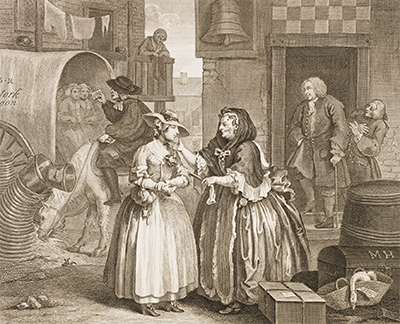Moll Hackabout Arrives in London at the Bell Inn Cheapside is an engraving by William Hogarth from 1732.
The first engraving in a series of six engravings depicting A Harlots Progress which followed the misfortunes of Moll Hackabout as she came to London and descended into the sad and degrading life of a prostitute. This was the first of William Hogarth's moral works and led to his recognition as a great artist and engraver. The series was widely copied and this led to Hogarth successfully lobbying in Parliament for legal protection for artists. The Engravers' Copyright Act came into force and was the first copyright law to protect visual arts and the rights of the artist.
This first engraving in the series shows Molls arrival at the Bell Inn in Cheapside, London. Dressed simply in a plain white dress signifying her innocence and naivety, she is met by an old lady. The old lady is Elizabeth Needham, a notorious brothel keeper who specialised in procuring young virgins by deception. Moll believes she has come for legitimate employment, probably as a seamstress, but the despicable pox ridden Elizabeth has obviously fooled her.
Behind these two stands Colonel Francis Charteris, an infamous pervert convicted of the rape of a young servant girl in 1731. The Colonel stands with his hand in his pocket, fondling himself while staring with obvious interest at the deception taking place. Next to him stands his pimp John Gourlay, in front of a decrepit old building signifying decadence and moral decay. Among Molls luggage is a basket containing a dead goose, a present to a cousin, though this cousin may have been part of the ploy to lure her to London. Goose was a common slang word for a prostitute and here also represents her coming death in the final scene.
People in the background of the scene seem oblivious to Molls plight. The clergyman mounted on a horse has his back turned to her and has no idea of the deceit that is taking place. His horse has disturbed a stack of buckets which topple, also signifying Molls moral fall from grace. A powerful series of engravings, A Harlot's Progress came at a time when public perception of prostitutes had shifted slightly to that of victims rather than initiators of moral corruption.




